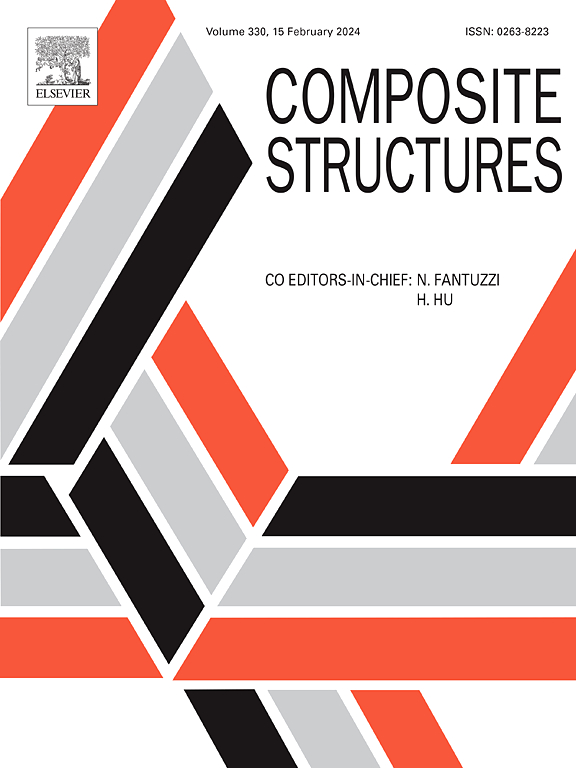三维打印增强i型断裂韧性和层间剪切强度的PLA/CF/CNT“微/纳米”多尺度纤维增强聚合物复合材料:热压后处理的影响
IF 7.1
2区 材料科学
Q1 MATERIALS SCIENCE, COMPOSITES
引用次数: 0
摘要
熔融长丝制造(FFF)三维(3D)打印使先进和复杂的纤维增强聚合物(FRP)复合材料成为可能,但也存在不可避免的高空隙含量和有限的层间强度。通过在纤维级添加纳米添加剂,多尺度增强可以有效缓解3D打印frp的面外性能限制。3D打印的聚乳酸(PLA)/碳纤维(CF)/多壁碳纳米管(CNTs)连续FRP复合材料具有增强的层间强度和断裂韧性。开发了一种定制的卷对卷(R2R)生产线,用于用纯PLA和PLA/CNT纳米复合聚合物溶液浸渍CF束(3k),进一步用作单进料FFF 3D打印(3DP)的原料。PLA/CF和PLA/CF/CNT单向(UD) 12层板([0]12)是制造和彻底研究通过微观结构和物理化学分析,以及机械测试,无论是“打印”(AP)和后处理的“热压”(TP)样品。即,准静态弯曲、短梁剪切(SBS)、i型层间断裂试验、动态力学分析(DMA)和断口学研究阐明了CNTs在3DP CFRP层压板中的增强机制,即通过基体加劲、裂纹挠曲等,显著提高了层间剪切强度(ILSS)和断裂韧性(GIC)。PLA/CF/CNT (TP)复合材料的极限抗弯强度(σUFS)提高了8.9%,存储模量(E′)提高了6.7%,ILSS提高了30.1%,GIC提高了32.0%。这项工作强调了一种有效利用连续3d打印frp热塑性基体内纳米内含物的通用方法,显示出增强的机械性能。本文章由计算机程序翻译,如有差异,请以英文原文为准。

Three-dimensional printing of PLA/CF/CNT “micro/nano” multi-scale fiber reinforced polymer composites with enhanced Mode-I fracture toughness and interlaminar shear strength: Effect of thermal press post treatment
Fused Filament Fabrication (FFF) three-dimensional (3D) printing empowers advanced and complex fiber-reinforced polymer (FRP) composites, but also possesses unavoidable high void content and limited interlaminar strength. Multi-scale reinforcement can effectively mitigate the out-of-plane performance limitations of 3D printed FRPs, by the incorporation of nano-additives at filament level. 3D printed continuous FRP composites of Polylactic acid (PLA)/ Carbon Fiber (CF)/ multi-walled carbon nanotubes (CNTs) with enhanced interlaminar strength and fracture toughness are reported for the first time. A custom roll-to-roll (R2R) line is developed for the impregnation of CF tows (3 K) with neat PLA and PLA/CNT nanocomposite polymer solutions, further employed as feedstock for single feed FFF 3D printing (3DP). PLA/CF and PLA/CF/CNT unidirectional (UD) 12-ply laminates ([0]12) are manufactured and thoroughly investigated through microstructural and physicochemical analyses, as well as mechanical testing, both for “as printed” (AP) and post-processed “thermally pressed” (TP) specimens. Namely, quasi-static flexural, short beam shear (SBS), Mode-I interlaminar fracture tests, Dynamic Mechanical Analysis (DMA) and fractography investigations elucidate the reinforcing mechanisms of CNTs in the 3DP CFRP laminates, i.e. via matrix stiffening, crack deflection, etc., significantly increasing the interlaminar shear strength (ILSS) and fracture toughness (GIC). The ultimate flexural strength (σUFS) is increased by 8.9 %, the storage modulus (E′) by 6.7 %, the ILSS by 30.1 % and the GIC by 32.0 % for the PLA/CF/CNT (TP) multi-scale composites. This work highlights a versatile approach for the effective utilization of nanoinclusions within the thermoplastic matrix of continuous 3DP FRPs showing enhanced mechanical performance.
求助全文
通过发布文献求助,成功后即可免费获取论文全文。
去求助
来源期刊

Composite Structures
工程技术-材料科学:复合
CiteScore
12.00
自引率
12.70%
发文量
1246
审稿时长
78 days
期刊介绍:
The past few decades have seen outstanding advances in the use of composite materials in structural applications. There can be little doubt that, within engineering circles, composites have revolutionised traditional design concepts and made possible an unparalleled range of new and exciting possibilities as viable materials for construction. Composite Structures, an International Journal, disseminates knowledge between users, manufacturers, designers and researchers involved in structures or structural components manufactured using composite materials.
The journal publishes papers which contribute to knowledge in the use of composite materials in engineering structures. Papers deal with design, research and development studies, experimental investigations, theoretical analysis and fabrication techniques relevant to the application of composites in load-bearing components for assemblies, ranging from individual components such as plates and shells to complete composite structures.
 求助内容:
求助内容: 应助结果提醒方式:
应助结果提醒方式:


